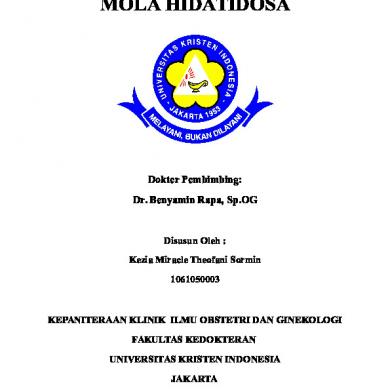Pancreatic Cancer
This document was uploaded by user and they confirmed that they have the permission to share it. If you are author or own the copyright of this book, please report to us by using this DMCA report form. Report DMCA
Overview
Download & View Pancreatic Cancer as PDF for free.
More details
- Words: 466
- Pages: 2
Loading documents preview...
Epidemiology
Pancreatic cancer is a “silent” killer, being the fourth most fatal cancer in both males and females in Europe and the US 1. The projected mortality in 2016 for pancreatic cancer is estimated as high as 42600 and 43000 for males and females in the EU, respectively, with an incidence of 7.88 and 5.60 per 100000 person-years for each sex 2. In the US, during 2016, an estimated 53070 people will be diagnosed and 41780 will die due to pancreatic cancer3. Mean age of appearance is 71 for men and 75 for women. The 5-year survival rate after resection is approximately 20%, which is feasible at 15-20% of patients presenting at centres of excellence1.
Etiology
It is well known that pancreatic cancer appears sporadically at 80-90% of affected patients, while there are more and less well studied causes of familial mutation pancreatic cancer1,4. A well-established relationship has been documented between cigarette smoking and pancreatic cancer, with an odds ratio of 2.2 for current smokers and 1.2 for former ones in a recent analysis of the PanC4 Consortium 5. Moreover, obesity, inactivity and a Western type diet are all associated with increased risk of pancreatic cancer. Chronic pancreatitis is also a known risk factor, with its leading cause, excessive alcohol consumption, being also linked to higher prevalence of pancreatic cancer in comparison with the general population. As far as familial cancer is concerned, the definition of which is a history of pancreatic cancer in at least two firstdegree family members, BRCA2 mutation is the most common cause. Others include Peutz-Jeughers, Li-Fraumeni and Lynch Syndromes, as well as, Familial Atypical Malignant Mole Melanoma.
Clinicopathological correlations
Pancreatic cancer is predominantly derived from the exocrine pancreas, at around 95% of cases, while the rest 5% come from endocrine cells. Approximately 95% of exocrine tumours are adenocarcinomas and the rest are cystic tumours. Pancreatic adenocarcinoma most commonly involves the head or the uncinate process of the pancreas (60-70%), but can also be located in the body or tail of the organ, or even in a 10-15% . Tumours of the body and tail are usually more aggressive and diagnosed at later stage of disease due to lack of symptoms. Patients usually are asymptomatic, while obstructive jaundice, abdominal pain, weight loss, duodenal obstruction, steatorrhea and new onset diabetes are symptoms that patients could present with. Diagnosis is established with multiple detector computed tomography (MDCT) with intravenous contrast agent, scanning at an arterial pancreatic phase (40-50 sec) and a venous phase (60-70 sec) after infusion. Magnetic resonance imaging
(MRI) is an alternative solution, with equal results, but better imaging of uncharacterised liver lesions. EUS
Principles of surgical therapy
Resectability, Procedures, R0 resection & vascular resection (venous – arterial)
Principles of systemic therapy Genomics – Personalised Medicine
Epidemiology
Pancreatic cancer is a “silent” killer, being the fourth most fatal cancer in both males and females in Europe and the US 1. The projected mortality in 2016 for pancreatic cancer is estimated as high as 42600 and 43000 for males and females in the EU, respectively, with an incidence of 7.88 and 5.60 per 100000 person-years for each sex 2. In the US, during 2016, an estimated 53070 people will be diagnosed and 41780 will die due to pancreatic cancer3. Mean age of appearance is 71 for men and 75 for women. The 5-year survival rate after resection is approximately 20%, which is feasible at 15-20% of patients presenting at centres of excellence1.
Etiology
It is well known that pancreatic cancer appears sporadically at 80-90% of affected patients, while there are more and less well studied causes of familial mutation pancreatic cancer1,4. A well-established relationship has been documented between cigarette smoking and pancreatic cancer, with an odds ratio of 2.2 for current smokers and 1.2 for former ones in a recent analysis of the PanC4 Consortium 5. Moreover, obesity, inactivity and a Western type diet are all associated with increased risk of pancreatic cancer. Chronic pancreatitis is also a known risk factor, with its leading cause, excessive alcohol consumption, being also linked to higher prevalence of pancreatic cancer in comparison with the general population. As far as familial cancer is concerned, the definition of which is a history of pancreatic cancer in at least two firstdegree family members, BRCA2 mutation is the most common cause. Others include Peutz-Jeughers, Li-Fraumeni and Lynch Syndromes, as well as, Familial Atypical Malignant Mole Melanoma.
Clinicopathological correlations
Pancreatic cancer is predominantly derived from the exocrine pancreas, at around 95% of cases, while the rest 5% come from endocrine cells. Approximately 95% of exocrine tumours are adenocarcinomas and the rest are cystic tumours. Pancreatic adenocarcinoma most commonly involves the head or the uncinate process of the pancreas (60-70%), but can also be located in the body or tail of the organ, or even in a 10-15% . Tumours of the body and tail are usually more aggressive and diagnosed at later stage of disease due to lack of symptoms. Patients usually are asymptomatic, while obstructive jaundice, abdominal pain, weight loss, duodenal obstruction, steatorrhea and new onset diabetes are symptoms that patients could present with. Diagnosis is established with multiple detector computed tomography (MDCT) with intravenous contrast agent, scanning at an arterial pancreatic phase (40-50 sec) and a venous phase (60-70 sec) after infusion. Magnetic resonance imaging
(MRI) is an alternative solution, with equal results, but better imaging of uncharacterised liver lesions. EUS
Principles of surgical therapy
Resectability, Procedures, R0 resection & vascular resection (venous – arterial)
Principles of systemic therapy Genomics – Personalised Medicine
Related Documents

Pancreatic Cancer
March 2021 0
Pancreatic Cancer
March 2021 0
Pancreatic Cancer
March 2021 0
Pancreatic Cancer
March 2021 0
Cancer
February 2021 2
Cancer
February 2021 1More Documents from "Noticiero Escolar Abs"

Pancreatic Cancer
March 2021 0
[julia_kristeva]_poderes_de_la_perversion.pdf
January 2021 1
Traders Mag Sep2013
March 2021 0
Balanced Scorecard Dan Biaya Kualitas.docx
February 2021 0
